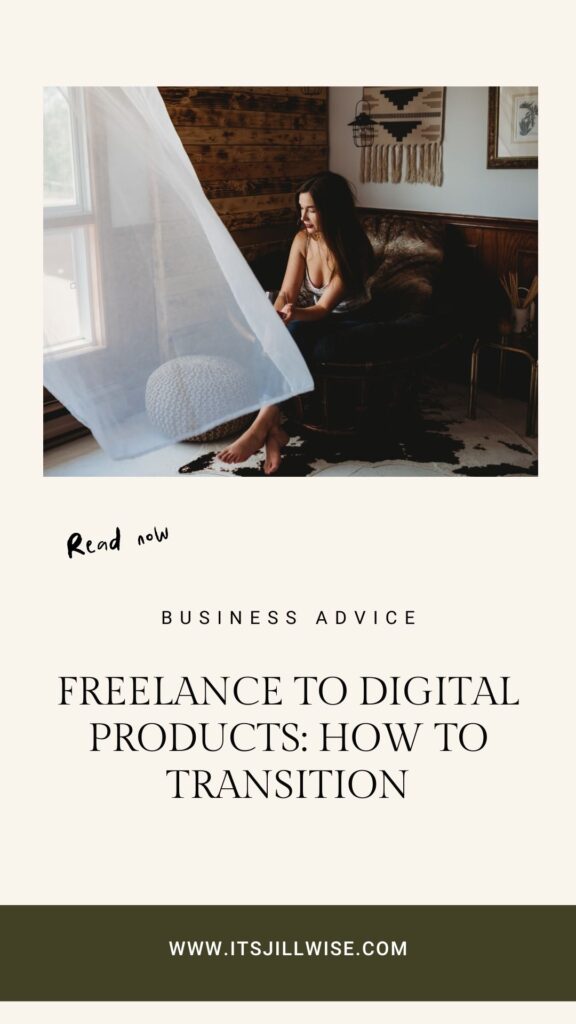If you landed on this page, I see you… You’ve been freelancing for a while. Probably years at this point. You’re tired. Maybe even teetering on burnout from all the client work you’ve been doing. You have big dreams. You want more from your business, and want to start detaching your earnings from your personal time. Rather than looking to scale your freelance business by growing a team, you’d prefer to keep things lean. Solopreneur life feels comfortable for you, and creating digital products to sell online sounds like the best next steps for your next season.
So you ended up here, searching for how to transition away from freelance services without burning everything down and starting from scratch.
I get it. I get being totally obsessed with your business, then looking for a different model to satisfy your current season of life. That’s the whole point of building a business that supports your lifestyle, isn’t it? Plus it’s normal for dreams to change, and while scaling may have looked different for you a few years ago, you’re here now.
Exploring passive income streams
Hopefully, the information I share and my own story is helpful for you to transition from freelance services to exploring more passive income streams as well. I should clarify that what’s often sold as “passive income” in the digital product space isn’t actually passive. Yes, you’re no longer bound by the time you have in a day to dedicate to client work, but it’s definitely not something you set and forget.
That said, transitioning from freelance services to digital products isn’t for everyone. Most notably, you need to be prepared to focus on audience growth for the long haul. But if you do decide to make a real go at this creator-style business model, you’re in the right place.
In this post, I’m going to share my experience of building and growing a digital product shop. We’re going to cover the following.
- How I added digital product revenue to my business model.
- Digital product ideas for freelancers, including ones I’ve tried.
- How to create and sell digital products.
- Developing your own digital products versus master resell rights.
- Tech tools you need to transition to this business model.
And if you do choose to start down this path, I’d love to know how it goes for you. Join my email list below to stay connected, or comment with your personal experience below.

How I added digital products revenue to my business
I added digital products to my business model years ago… Way back in 2019. First, as a fun experiment… Like could I really do this? From there, my digital product shop, The Biz Bar, became a place for me to play and learn, testing out new strategies that I could then bring to my clients in my micro marketing studio. The shop also allowed me to continue to help an audience of newer solopreneurs as my done-for-you offers grew beyond them to target more established businesses. Check, check, and check.
Bonus points is that The Biz Bar has become a legitimate revenue stream for my business. And I hope your digital products to sell online help you make money too.
Start small and grow from there
My first digital product was a PDF download with caption templates for Instagram. It was very simple and leveraged something I was known for. I grew my audience from 300 to a few thousand fairly quickly, and people liked my captions. After purchasing, customers were emailed a link to get the PDF. They could copy and paste the captions into their content scheduler and fill in the blanks, kind of like Mad Libs.
That product went through multiple variations. It grew to include educational resources and further prompts beyond just the captions. Now, it’s no longer available in my shop, but it served its purpose for years!
From there, my shop expanded to include a handful of templates. I’ve also hosted group programs and digital courses, both in a group and self-paced setting. I’ve tried it all, and have helped clients find their best fit too. This strategic experimentation, trial and error and validation, brings me to the current season of my business.
Focus on what works next
What works best for my business and current capacity is keeping things simple in The Biz Bar with tools and templates for solopreneurs to DIY their marketing and messaging. Aside from my digital products, but also on the educational side of the business, I run a mastermind for solopreneurs, freelancers, and personal brands. This combination approach for the educational side of my business feels good right now, and is the direction I plan to stick with. I don’t want to have lots of calls on my calendar, or busy launches to schedule around. Simple, easy, and evergreen is my low-lift digital product sales strategy at the moment.
As we bring this back to your business, maybe you want to launch a course, and run that for a while. Or you’d prefer to start with a micro-offer of a digital product. Or maybe you’re just getting started looking for your big idea, which leads to the next topic of our conversation: Digital product ideas for freelancers.

Digital product ideas for freelancers
What’s the best digital products to sell online? That depends on your area of expertise; your ready to package intellectual property; current platform size, type, and engagement; and your life and business goals. I always recommend that you leverage what you already have versus starting over. This advice was given to me a few years ago: If you’re a papermill, sell your wood chips. Sell the clippings. Take advantage of the low hanging fruit around you first. Focusing on strong foundations will help you reach your goals faster versus trying to start from nothing.
I also like to look at how I can leverage every effort in my business at least 3 times. For example, if I build a new SOP for myself and my team, that SOP will help us be more efficient. I’ll save time. It will also become something I can teach on and maybe share with my mastermind community because they get access to these backend pieces. And finally, this SOP could be something that I talk about on a guest feature or podcast as an example of how my business operates, which would work to bring in clients. There’s 3 direct and indirect uses. I could also package it up and sell this SOP as a digital product.
Your digital products could work the same.
Digital product ideas for freelancers in 2024
Consumer behaviour is changing, and has been changing for a while. Where lengthy courses and group programs used to do really well, I’m noticing a shift towards plug and play templates for quick DIYers, then high-touch programs on the opposite end of the spectrum. People have less time and patience, so they want the quick fix via the templates, and customized advice with intimate support.
Digital product ideas for freelancers:
- Social media graphics
- Brand bundles
- Website templates
- Website copy templates
- Project management templates
- Photography presets
- Proposal and contract templates
- Cheat sheets
- Mini courses
- Semi-customizable offers, like a website template with a booked customization add-on
Anything that takes either a piece of what you offer in a done-for-you capacity, or is a part of how you run your business could work as a digital product.
Don’t overcomplicate it
When building your first digital product, please don’t overcomplicate the process for yourself. Your first offer doesn’t need to be a robust course that you’ve built and developed entirely before launching. Often, it’s smarter to start with a beta offer, then build from there. Get a few sales, collect feedback, and improve.
You don’t even need all the pieces ready to launch. You could get buy-in from a handful of people to validate your idea prior to building anything beyond the outline… Basically all you need to sell it is the outline and the promised transformation.
I mentioned that my first product was a PDF download. You could do something like that or a mini course. I used a mini course as my free lead magnet for years. I’ve also seen templates for project management tools, photography presets, e-books, and guides work really well depending on your industry. Graphic designers can do website templates or semi-customizable brand elements. You could also give away parts of your business property. For example, I’ve been thinking about selling my proposal templates that bring in 5-figure projects for other copywriters to use (let me know if you’d want this!).
Check out this blog post for a complete list of digital product ideas for freelancers.
How to sell digital products
The first thing you’re going to need when you start selling digital products is a way to actually sell them. I use ThriveCart Learn+ to host and sell all my digital products. You can read my full ThriveCart Learn+ review here… This is where I explain why I think ThriveCart Learn+ is the best course platform. I’ve used most of the competing options either for my own products, while supporting clients, or as a student within the course platform. I’ve used Kajabi, Thinkific, Teachable, Squarespace, and think ThriveCart Learn+ is the best course platform for freelancers transitioning to sell digital products.
Why is ThriveCart Learn+ the best course platform? The main reasons are because of the checkout capabilities, including the option to collect location-based sales taxes (which is mandatory if you’re Canadian like I am and make over the threshold for your province). I also like how easy it is to set up your products as a course creator, the simplicity of the platform, and the user experience for your customers and course students.
Get started using ThriveCart here.*** This is an affiliate link that earns me a small commission at no additional cost to you.
How to get started selling digital products
If you’re transitioning from selling freelance services to selling digital products, you will likely have an easier time than someone starting from scratch. Yay! That’s a relief. Now where do you start? First, you need to come up with your idea for your digital products to sell online. Then you need a way to sell it. The messaging and marketing strategy come next. And of course, delivery.
How to transition from freelance services
My best advice for transitioning from selling freelance services to a business model with digital products is to leverage what you’ve already built.
- Build on your current platform. Use your existing audience to grow a following that aligns best with your digital products. This could look like optimized content that hits both targets, or even setting up an affiliate program for your digital products.
- Lean into what you know best, and what you’re best known for. If you’re getting great results selling a specific service, offer, or transformation, is there a way to package the same (or similar) results in a digital product format? For example, as I became known for website copywriting, it made sense to offer website copy templates. No need to reinvent the wheel!
- Understand the differences. Selling digital products is slightly different from selling freelance services. Acknowledging these differences will help you market both appropriately. It may involve getting outside of your comfort zone.
- Develop a new marketing plan. You’ve probably heard the saying, “What got you here won’t get you there.” This is true for selling digital products online too. Take a look at my low-lift 2024 marketing strategy that I shared here for some ideas.
This blog post is your complete A to Z checklist of how to sell digital products.
Fit your digital products into your capacity planning
If you’re transitioning from selling freelance services to the digital product model, the biggest roadblock for you is going to be time available: How do you fit your new project into your schedule that’s likely packed with client work? I’ve seen success for myself and clients in a few ways.
Option 1: Add a large block of time into your calendar to book yourself like a client. Maybe it’s a week or a month where you don’t take any client work. Just focus on building your digital products.
Option 2: Add yourself to your regular schedule like a client. This could be on a daily or weekly basis, you set aside X hours to chip away at the bigger project of developing digital products.
Neither option is better or worse. It’s just a matter of what works best for you. I’ve tried both at various stages of my journey, and was able to make progress both ways. What’s most important is that you get the time into your calendar, otherwise it won’t happen. Too often, I see freelancers who want to transition say that they want to for years, but they never make the legitimate time to do it. It really is like building a new business sometimes, so you need to give the required work that space.
Digital Products vs Master Resell Rights
Which is better: Building your own digital products? Or buying something with master resell rights? I’ll preface this by making it clear that every time I’m asked which option is better, I will always recommend that you create your own digital products to sell that are your original intellectual property… Don’t waste your time with master resell rights digital products that someone else has created and profits off of when you buy into the scheme.
If you aren’t aware, master resell rights digital products are an umbrella term for courses and other digital IP that’s sold as “business in a box.” They promise that if you take this course, not only will you learn “digital marketing,” but you’ll also learn how to package and resell this course to your audience. Sounds off, right?
The problem is that your offer isn’t unique, and you’re technically competing with everyone else who is selling the exact same offer, including the person who you purchased from.
I’m not the only one who shares this perspective about master resell rights digital products. Here’s another digital products expert who has a similar take on the pros and cons of building a business on master resell rights products.
How to create digital products
So you’ve decided that you want to create a digital product. Where do you start? I touched on this a bit already, but you need a big idea. That’s all! You can validate your idea by starting to sell it before it’s even built. From there, you build.
You could also build everything prior to launching, but that may end up with you doubling your work because the initial feedback results in so many requested changes. Again, there’s no wrong answer. It’s just something to be aware of.
This blog post breaks down every step for you to create a digital product.
For additional support, check out the Digital Product Sales Pack.
Disclaimers about digital products
Some disclaimers that you need to remember when building your digital product business: It’s not going to be easy, quick, or perfect. It’s a huge learning curve even for established entrepreneurs.
Also, the promise of passive income isn’t true. “Passive” actually means you become a marketing machine filling the top of your funnel while your automations work for you on the backend. But when this business model pays off, it can change your life and business for the better.
Best of luck. You’ve got this!

Related
Leave a Reply Cancel reply
Leave your info below to join. You'll be added to my email list, but can opt out at any time.
